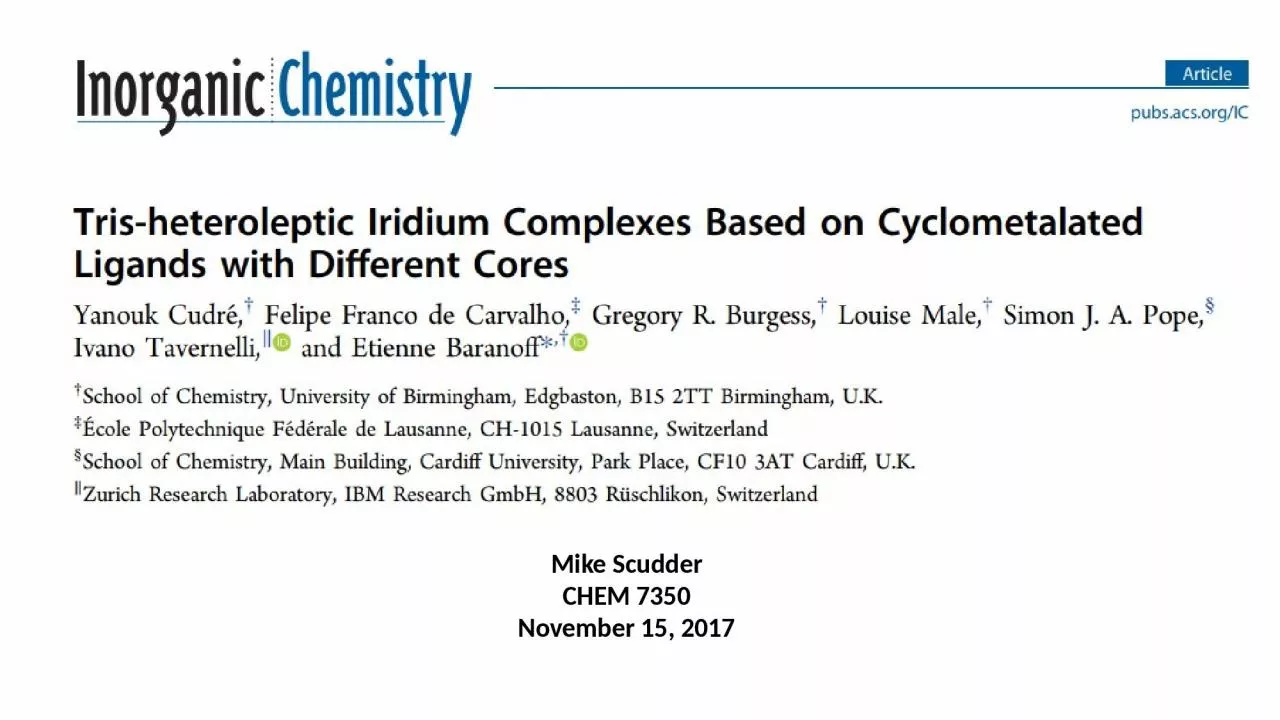

d 6 RuII Os II give long excitedstate lifetimes high luminescent efficiencies increase likelihood of either an energy or electrontransfer process occurring prior to radiativenonradiative ID: 935259
Download Presentation The PPT/PDF document "Mike Scudder CHEM 7350 November 15, 2017" is the property of its rightful owner. Permission is granted to download and print the materials on this web site for personal, non-commercial use only, and to display it on your personal computer provided you do not modify the materials and that you retain all copyright notices contained in the materials. By downloading content from our website, you accept the terms of this agreement.
Slide1
Mike Scudder
CHEM 7350
November 15, 2017
Slide2d
6
Ru(II),
Os
(II) give long excited-state lifetimes, high luminescent efficiencies (increase likelihood of either an energy or electron-transfer process occurring prior to radiative/nonradiative relaxtion)d6 Ir(III) exhibits longer lifetimes in solution due to heavier SOC
Slide3Cyclometalated
iridium complexes
Have generated intense interest due to excellent
photophysical
properties
Rational design and selection of the
cyclometalating
ligand and ancillary ligand provide an opportunity to control the
photophysical, electrochemical, and steric properties
Slide4Cyclometalated
iridium complexes
Absorption and emission spectra of (
ppy
)
2
Ir(
acac
)
2
OLEDs
LECs
Current density (open squares) and luminance (triangles) vs time at 4V bias in an
Ir
(ppyPbu
3
)
3
:(PF
6
)
3
3
Exhibit wide color tunability, high phosphorescence
Φ
Photophysical
, electrochemical properties crucial for materials performance
Dye-sensitized solar cells
1
Slide5Controlling emission wavelength in
Ir
complexes
Ancillary ligands
blueshift
the absorption and emission energies by stabilizing HOMO, leaving LUMO unchanged
Destabilization of the
1
MLCT state results in a decreased
1MLCT character in the lowest excited state, becomes more ligand-localized
Thompson et al. Inorganic Chemistry 2005 44 (6), 1713-1727
Slide6Controlling
k
r
,
k
nr
in iridium complexes
Excited-state lifetimes and quantum yields are used to calculate
k
r
, knrkr: based on the amount of metal character in emitting excited state, energy gap between singlet and triplet states
k
nr
: intramolecular
vibronic
coupling and thermal accessibility of metal-centered states
Thompson et al.
Inorganic Chemistry
2005 44 (6), 1713-1727
Slide7Structural modifications of
Ir
complexes
Potential (V vs Fc+/Fc)
Current
k
nr
k
r
3
A
1
A*
1
A
ISC
E
phosphorescence
hν
-E
fluorescence
hν
“Static Properties”
“Dynamic Properties”
Both static and dynamic properties sensitive to complex architecture
Motivation
: Find design approach to allow variation of
k
r
,
k
nr
independently of redox potential and emission maximum
Slide8Synthetic Approach: Tris-
heteroleptic
complexes
Not emissive at room temp.
Slide9Cyclic voltammetry results (complexes 1-10)
E
ox
(V)
0.43
0.73
0.58
E
ox
(V)
0.49
0.79
0.64
E
ox
(V)
0.45
0.75
0.61
0.60
Slide10Cyclic voltammetry results (isomers)
E
ox
(V)
0.73
0.72
0.76
0.73
Each diastereomer contains at least one pyridine group: quasi-reversible redox
Replacing
acac
with pic: shifts both potentials by 150 mV
Slide11UV-Vis results
LC
1
ππ
*
MLCT
Direct population of
3
A
Ppz
ligand: not emissive at room temperature
Replacing
ppy
with
ppz
has negligible effect on redox potentials, emission spectra
Significant impact on
k
r
,
k
nr
Slide12UV-Vis results
Emission maxima dictated by the overall number of fluorine substituents on the complexes
Complex 5: Not emissive at room temperature
Slide13UV-Vis results
Placement of F on ligand: no effect on redox/emission maxima
Significant effect on
k
r
,
k
nr
Slide14UV-Vis results: tris-
heteroleptic
isomers
Unlike
acac
, pic is asymmetric and
nonchromophoric
Resulted in
blueshift
relative to
acac complexesIsomers a and b: very similar absorption spectra
Close similarity confirmed by theory
Slide15Tris-
heteroleptic
isomers: density differences
Blue represents electron density, red represents hole density
First excited state of both isomer has MLCT character, large HOMO-LUMO contribution
T1: Combination of MLCT and LC character
Slide16Summary
A series of
bis
, tris-
heteroleptic
cyclometalated
iridium (III) complexes synthesized.
Use of picolinate as ancillary ligand provided two pairs of diastereomers.
Absorption, emission wavelengths and redox properties: controlled by overall structure of complexes.Radiative, non-radiative constants: controlled by specific placement of substituents.
Demonstrated it is possible to vary kr, knr without significantly affecting other properties.